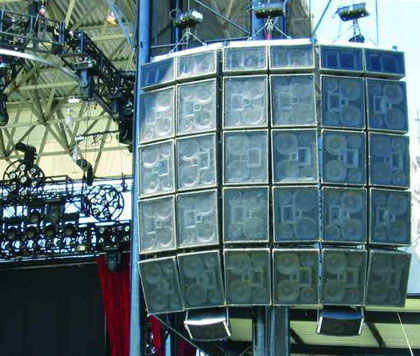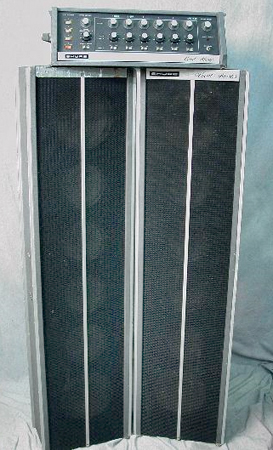
Sum Of Parts
The other approach utilized for larger acoustic spaces with loudspeaker is what I will called “summed” – the attempt to get the output of multiple loudspeakers to work together and act as a single larger loudspeaker source.
The coverage pattern of this giant loudspeaker is then adjusted and optimized to cover the listening area by varying the angles between the individual boxes.
The big challenge with the summed approach is optimizing the “cooperation” between the various loudspeakers, generally achieved by physically aligning the loudspeakers very close together in order to minimize them acting as separate sources. (Subwoofer arrays almost always act as summed arrays.)
A common goal of well-designed versions of both approaches is to avoid is having a listener hear two acoustically “separate” sources that are in close proximity to each other that are also not equidistant from the listener.
Why? Well, mainly because non-equidistant sound sources reproducing the same signal creates comb filtering issues that reduce output levels, messes up the frequency response, and most importantly, does not sound very good to our ears.
The summed approach, until recently, was considerably less widespread, with examples being Clair Bros S-4, my company’s (Rat Sound) Rat Trap 5, and to a certain extent, Showco Prism. (The actual components and configuration of Prism were kept “secret,” so it is my opinion, based on mixing on the system and its sonic characteristics, that lead me to believe that it’s based on a summed-output type design.)

These loudspeakers tend to rely on boxes with quite a few drivers in each box, placed in relatively close proximity to each other allowing them to unify their outputs. A major issue can be the physical spacing between the loudspeakers, which can cause them to act as multiple sound sources, creating box-to-box overlaps, comb filtering, and inconsistencies in coverage patterns.
On The Line
Sound, like everything else in life, is never perfectly black and white, instead existing in varying levels of gray, so the reality is that practically all real-world concert sound systems exhibit varying degrees of both approaches. Low frequencies tend toward summed, while high frequencies tend toward zoned.
The techniques sound system designers implement to push toward zoned or summed, and at what frequency that transition occurs, is a key factor in clarity, coverage consistency and versatility.
One off-shoot of the summed approach is the line array. By the way, line arrays are not new — the concept has been around and utilized for decades. One example is the venerable Shure Vocalmaster, a popular portable PA of the 1960s, which used a vertical line of 10-inch cone drivers within a single loudspeaker cabinet.

Take a close look at a Clair S-4 and you can see that the 18- and 10-inch cone drivers form vertical line arrays when stacked. The Rat Trap 5 could also be configured in a line-type array.
Through the mid-1990s, the high frequencies of large-scale pro audio systems behaved as a zoned system. while the low frequencies behaved in a summed manner. The major difference between the two approaches was the overall quality of the zoning or summing, and the frequency that the transition from summed to zoned occurred. The designers of zoned systems aimed for a lower transition frequency, while designers of summed systems aimed for a higher frequency.
Then along came a loudspeaker approach from L-Acoustics first embodied in what they called V-DOSC, which for the first time on a truly large scale employed a fully summed-output approach that effectively incorporated the high-frequency components in the summing. A unified design approach now existed, where system designers were able to either eliminate the transition from summed to zoned or push it to such a high frequency that it was relatively insignificant.
